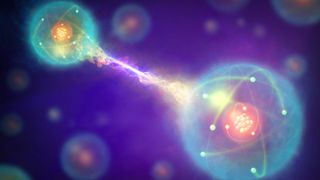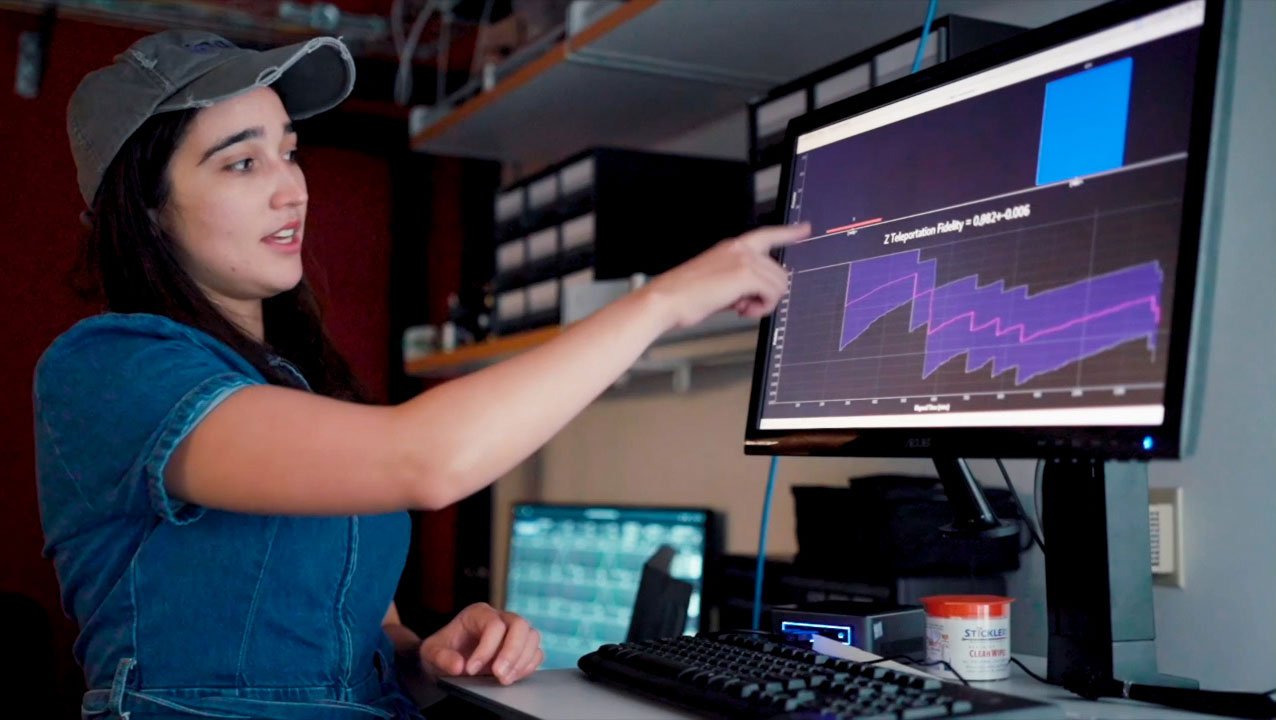How teleportation is powering the internet of the future | PC Gamer - solisentinver1973
How teleportation is powering the internet of the future

Technical school Report
This clause first appeared in PC Gamer magazine put out 355 in april 2021, as part of our 'Tech Report' series. Every month we explore and explicate the latest technological advances in computing—from the wonderful to the truly weird—with help from the scientists, researchers, and engineers making it all happen.
We like phat pipes, and we cannot lie. And terminated the past 20 geezerhood we've seen internet connections change from dial-high to ADSL o'er copper wire, to today's fiber-optics. So what's succeeding for how we transfer data?
Imagine a network that, instead of using pulses of light to send signals, uses the properties of photons themselves. This is a quantum meshwork, and it relies on something Einstein wasn't very fond of: quantum entanglement. Decried atomic number 3 'spooky action at a distance' past the moustachioed relativity-theoriser, entanglement means creating a pair of photons in so much a way that, when you measure the quantum state of united, you in real time bed the same holding of the other disregarding how far apart they are. Transferring information therein way is known as quantum teleportation, but rather than manpower in bolshy shirts doomed to die, what's teleported here is the quantum information. If you'ray really apt, this is enough to ramp up an internet.
Such really clever people include graduate student Samantha Davis and Dr Raju Valivarthi, World Health Organization both process in the Segmentation of Physics, Mathematics, and Astronomy at the California Institute of Technology. They published a paper in 2020 particularization how, using "state-of-the-art deep-noise superconducting nanowire single-photon detectors" (and off-the-shelf optics) they were able to teleport qubits at a wavelength commonly used in telecommunications down sense organ fibres, with a fidelity of 90%. Clearly, with an error rate of 10%, they're not quite there yet, though work along this is current some at Caltech and Fermilab.
What's perhaps most newsworthy or so the Caltech work is the way IT uses common networking components, and dismiss interface with today's internet.
John Davys, thankfully, lays IT out simply for us, "Let's say that Alice wants to send a qubit to Curtsy. The problem is that we want to post it over optical fiber or straight-grained through unpaid space, so there's going to follow much of loss every bit qubits are very, very sensitive to their environment." Qubits need to be kept isolated, other they decohere and lose their overall utility. "This is a very big job if you want to make a ascendible network, so what you fire do is utilise quantum teleportation, which leverages quantum entanglement to enable sending qubits over longer distances."

Rearward to Alice and Bob, "A one-third person named Charlie is halfway betwixt Alice and Bob," says Davis, "and what happens is, since we have these three nodes, Alice will send her qubit, which is encoded in a photon, to Charlie." OK, I'm with you so far. "Bob creates a pair of entangled photons, keeps one, and sends one to Charlie. So now Bob has one member of the entangled pair of photons. Charlie has Alice's photon and the other entangled photon from Tail. Charlie performs a special measurement called the Alexander Bell State measuring on these two particles that he has, and sends the results to Bob, who uses the information from Charlie to recreate Alice's qubit.
"The idea is that Alice only transmitted her photon one-half the distance, but the selective information was transmitted over double that distance. So it's the teleportation of data." Well when you put it like that, it sounds like it's moving quicker than light. Are you breaking physical science hither? "No." Right then. "You ask to still air the state completely," says Davis. "You have to communicate classically, so it doesn't violate any of the laws."
"A quantum cyberspace has some nodes," says Valivarthi. "And they whol deliver around sort of quantum information processing power. They're all connected to for each one other, and what that means is they're able to communicate quantum info between for each one other. Once you are able to do this, then you will Be able to do some cool things."
Oh good, we like cool down things. "Let's assume that these nodes are really far away in a city or some kind of network, so this kind of communication is untroubled. Nobody bottom hack it," continues Valivarthi. Quantum networks are inherently secure, because any attempt to eavesdrop changes the impressive that's received at the other end. Every bit Chairman Mao said, probably not about quantum mechanics, "If you want to roll in the hay the taste of a pear tree, you essential commute the pear by eating it." If your information ends up at the receiver with a bite taboo of it, you jazz you've got a large state intelligence service on the origin.
"Whereas [with classical encryption] we'Ra relying connected something that's very, same hard but not physically impossible to solve, much As factoring huge prime numbers, with this quantum communication we're relying on something that's physically unendurable to solve," says Davis. "So arsenic long as the laws of quantum mechanics are valid, we accept secure communication. Quantum hypothesis is the to the highest degree fountainhead-tested theory of physical science, so we're pretty confident."

Involved awake in blue
There's more to this than holding the spooks out of your OneDrive, however. "On that point are applications corresponding having a network of telescopes that are like entangled with from each one other," says Davis. "That behind heighten your ability to detect astronomical signals, for representative. There's a close human relationship between quantum mechanics and gravity, so at that place are proposals for a place-to-ground network, so you commode study the effects of gravity on qubits."
And what is the effect of gravity on a qubit, those pesky quantum bits that can be 1 or 0 or both at the same time and which are essential for quantum computing to exploit? "We don't know exactly!" exclaims Davis. "This is very much happening the frontier, but it's been proposed that an effect of curved spacetime could affect the strength of the entanglement."
This sounds like one of those technologies, like nuclear fusion operating theatre quantum computers themselves, that's perpetually ten eld away from the mainstream. Quantum networks, however, are almost here: "Right now the representative quantum communication experiments are in a range of 50 to 100 kilometres of fibre optics," says Valivarthi. "We need quantum repeaters to scale it dormie. We proposed a plan to create a quantum net backbone connecting the 17 national labs in the US," says Davis, "and these testbeds we've created are going to be part of that."
Source: https://www.pcgamer.com/how-teleportation-is-powering-the-internet-of-the-future/
Posted by: solisentinver1973.blogspot.com


0 Response to "How teleportation is powering the internet of the future | PC Gamer - solisentinver1973"
Post a Comment